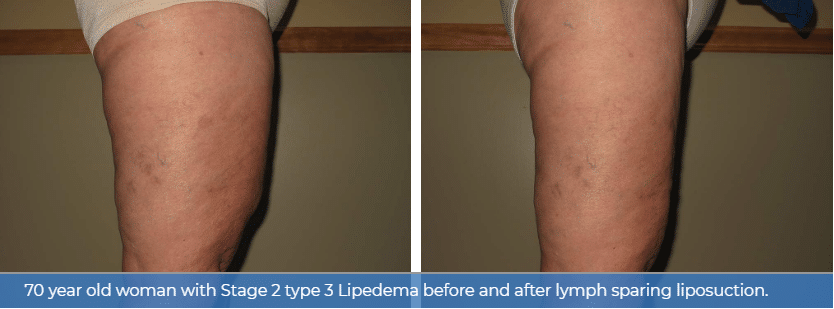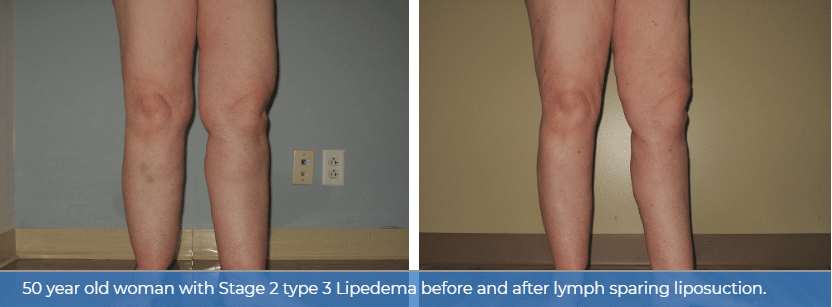Liposuction is one of the most effective ways to treat lipedema, but extra caution must be taken in its execution. With any surgical cosmetic procedure, extreme caution should be taken to avoid any unnecessary risks, and liposuction is no exception. Lymph sparing is a special type of liposuction specifically designed for patients who need extra precautions to protect their lymphatic function.
While all surgeries have some risks, lymph sparing liposuction – when done properly – has some of the lowest risks associated with the any procedure. Cosmetic surgeons ensure their patient’s health through a variety of preparations and precautions before, during, and after the procedure. Several of these necessary procedures include decongestion, avoiding general anesthesia, treating varicose veins, limiting the amount of fat removed, and having a cosmetic surgeon who understands the many surgical techniques involved with lymph sparing liposuction.

Before and After Lymph Sparing Liposuction in St Louis
Decongestion of Tissue Before and After the Lymph Sparing Liposuction Surgery
Prior to any surgical procedure, the lipedema tissue needs to be completely decongested. Tissue congestion is how the medical field describes tissue which is swollen because of impaired lymphatic flow. Decongestion or removing the swelling is best achieved with a variety of options, including manual lymph drainage, a type of massage that is directed at moving lymph fluid from a swollen area, compression garments, intermittent pumps, and wraps. This can not only relieve lipedema symptoms, but decongestion also ensures the liposuction area is in the optimal shape prior to surgery.
Several benefits typically include a reduction of tenderness, heaviness, and feeling less fatigue, as well decreased inflammation in the tissue. Lipedema patients also typically have medical conditions that can cause a higher risk of complications. After the liposuction surgery there is always increased swelling in the tissue treated, which if it is not aggressively treated can worsen the symptoms of lipedema. When liposuction is performed on lipedema patients, proper recovery is dependent on restoring and optimizing lymphatic flow and function.
Manual Lymph drainage, wraps, compression garments and compression pumps are very important to move the lymphatic fluid in the swollen treated area back into circulation. If the swelling is untreated it can lead to problems such as a secondary lymphedema. That is why liposuction on lipedema patients should include plans and precautions to encourage optimal lymph circulation before and after the surgery.
Avoiding General Anesthesia for Lymph Sparing Liposuction Procedures
Liposuction procedures using a generous tumescent technique are able to avoid several procedural complications that often arise through the use of general anesthesia. Procedures using general anesthesia usually have a high risk of 0.3% for complications for individuals who have less than perfect health. The use of general anesthesia should be avoided for lymph sparing liposuction procedures. Tumescent anesthesia also allows for more movement during the procedure and a faster recovery.
Treating Varicose Veins
Varicose veins larger than 4.0mm are one such medical condition that must be treated prior to any lymph sparing liposuction. Varicose veins this size can increase the risk of bleeding during the liposuction procedure and a rare complication called fat embolism.
Removing Fat Sparingly
Limits on the amount fat that can be safely removed is most likely the last thing a patient wants to hear when undergoing lymph sparing liposuction. However, removing too much fat can cause trauma to the skin and create another set of issues for the patient. Up to 5.0 liters of fat can be safely removed, but going significantly past that increases the likelihood for procedural complications. Volume limits exist in states such as California and Florida when patients request to remove more than what is advised by the cosmetic surgeon.

Before and After Lymph Sparing Liposuction in St Louis
Receiving Your Procedures Safely
Any cosmetic surgeon who understands particular surgical techniques can avoid surgical complications along with the above preventative measures. Many lymph pathways are import to avoid. Surgeons should also avoid any suctioning in a longitudinal manner that is parallel to other ducts in the facial area. Through these five surgical preventative measures, you can receive lymph sparing liposuction with minimal risk.
References:
Gottschalk, A. H. (2011). Is Anesthesia Dangerous? Dtsch Arztebl Int. International, 469-474. doi: 10.3238/arztebl.2011.0469